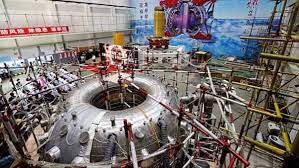
According to the state media report, China successfully powered up its “artificial sun” nuclear fusion reactor for the first time, marking a great advance in the country’s nuclear power research capabilities.
Daily Current Affairs Quiz 2020
Key-Points
The HL-2M Tokamak reactor is China’s largest and most advanced nuclear fusion experimental research device, and scientists hope that the device can potentially unlock a powerful clean energy source.
It uses a powerful magnetic field to fuse hot plasma and can reach temperatures of over 150 million degrees Celsius, approximately ten times hotter than the core of the sun.
Located in Sichuan province and completed late last year, the reactor is often called an “artificial sun” on account of the enormous heat and power it produces.
Chinese scientists have been working on developing smaller versions of the nuclear fusion reactor since 2006.
Fusion reaction is what powers our sun. It merges atomic nuclei to create massive amounts of energy – the opposite of the fission process used in atomic weapons and nuclear power plants, which splits them into fragments. Unlike fission, fusion emits no greenhouse gases and carries less risk of accidents or the theft of atomic material.





